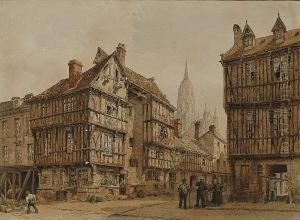Edward Salomons Paintings
Edward Salomons was a British architect born in 1828 in Manchester, England. His contributions to architecture, particularly in the Manchester area, were significant during the Victorian era. Salomons was not only an architect but also an active member of the Manchester Society of Architects, serving as its president at one point. His work reflects the eclectic tastes of the period, often incorporating Gothic, Renaissance, and Classical elements.
Salomons was apprenticed to the architectural firm of Travis & Mangnall in Manchester, which provided him with a solid foundation in the field. He later established his own practice and became known for his work on several important buildings. One of his notable designs is the Manchester Reform Club, completed in 1871, which is an example of his skill in designing opulent and prestigious public buildings. He also designed the synagogue on Park Place in Manchester, demonstrating his ability to work on religious buildings with sensitivity and style.
Throughout his career, Salomons was noted for his attention to detail and his ability to work with a variety of architectural styles. His buildings often featured intricate facades and a careful consideration of proportion and space. Despite his success, Edward Salomons did not gain the same level of fame as some of his contemporaries. However, his work remains an integral part of Manchester's architectural heritage.
Salomons' contributions to architecture extended beyond his own practice. He was a keen advocate for professional development within the field and mentored many young architects. His interest in the advancement of architecture as a profession, as well as his involvement in various architectural societies, helped to shape the architectural landscape of Manchester and beyond.
Edward Salomons passed away in 1906. His legacy is preserved in the buildings he designed and in the impact he had on the architectural community. Though not a household name, Salomons’ work continues to be appreciated by architects, historians, and those who encounter his enduring structures.
